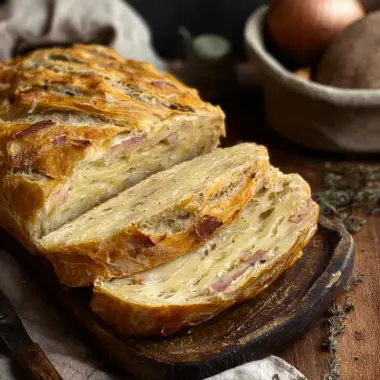Yorkshire Pudding is a timeless British classic that brings an extra dimension to any roast dinner. With its crisp, golden exterior and pillowy interior, this savory baked treat is more than just a side it’s an experience. Traditionally served alongside roast beef and rich gravy, it’s a staple of the beloved Sunday roast and holiday feasts across the UK. Whether you’re hosting a festive family dinner or simply craving comfort food with depth, these Yorkshire Puddings deliver. Their rustic charm, effortless preparation, and show-stopping puff make them a crowd-pleaser every time. Once you master the technique of hot fat and rested batter, you’ll have a reliable go-to recipe that always rises to the occasion literally and figuratively.
Full Recipe:
Ingredients:
-
1 cup all-purpose flour
-
1 cup whole milk
-
3 large eggs
-
1/2 tsp salt
-
1/4 cup beef drippings (or vegetable oil)
Directions:
-
Preheat your oven to 425°F (220°C).
-
In a mixing bowl, whisk together the flour, eggs, milk, and salt until the batter is smooth and lump-free. Let it rest for at least 30 minutes at room temperature.
-
Place a small amount of beef drippings into each compartment of a 12-cup muffin tin (or a traditional Yorkshire pudding tin).
-
Place the tin in the oven and heat until the fat is smoking hot about 5-7 minutes.
-
Carefully remove the hot tin from the oven and immediately pour the batter evenly into each compartment, filling each about halfway.
-
Return to the oven and bake for 20-25 minutes without opening the door. The puddings should puff up and turn golden brown.
-
Serve hot, ideally with roast beef and gravy.
Prep Time: 10 minutes | Cooking Time: 25 minutes | Total Time: 35 minutes
Kcal: 180 kcal | Servings: 6 servings
Yorkshire Pudding: The Quintessential British Side Dish
Yorkshire pudding is one of the most iconic elements of British cuisine a dish so simple in its ingredients yet so grand in its culinary presence. Whether gracing the plate beside a perfectly roasted beef joint or starring in its own right with lashings of gravy, this airy, golden-brown delight evokes a sense of tradition, comfort, and timeless appeal.
This article dives deep into the world of Yorkshire pudding, exploring its rich history, cultural significance, ideal pairing options, preparation tips, and why it continues to hold a cherished place at Sunday tables across the UK and beyond.
A Glimpse into the History of Yorkshire Pudding
The origins of Yorkshire pudding trace back to the 18th century in northern England. It began as a clever way for frugal cooks to make use of the drippings from roasted meat. Early references to the dish appear in “The Whole Duty of a Woman,” a 1737 cookbook that referred to it as “A Dripping Pudding.”
In 1747, the term “Yorkshire Pudding” first appeared in Hannah Glasse’s influential book The Art of Cookery Made Plain and Easy. At the time, the people of Yorkshire were known for their use of coal ovens that generated higher heat, allowing the puddings to rise taller and become crisper than in other parts of the country. Thus, the name “Yorkshire” became a proud hallmark of this perfected recipe.
What Exactly Is Yorkshire Pudding?
Despite its name, Yorkshire pudding is not a dessert pudding as understood in other cultures. Instead, it’s a savory side made from a batter of flour, eggs, and milk or water. It’s poured into a tin containing hot beef drippings or oil and baked in a very hot oven until puffed and golden.
The magic of Yorkshire pudding lies in the contrast between its crispy exterior and soft, slightly custardy center. While traditionally served as a side dish, modern interpretations have expanded its use into main courses and even creative appetizers.
Why Yorkshire Pudding Remains a Staple
Yorkshire pudding is more than just a side dish it’s a symbol of British culinary identity. Here’s why it continues to be beloved:
1. Simplicity of Ingredients
The batter consists of only a few pantry staples flour, eggs, and milk. This accessibility has made it a go-to recipe for generations of home cooks.
2. Versatility
While traditionally accompanying roast beef, Yorkshire pudding is flexible enough to be served in different ways. It can hold stews, be turned into wraps, or act as a savory base for creative fillings.
3. Cultural Significance
Few dishes evoke the charm of a traditional Sunday roast like Yorkshire pudding. It brings families together, especially during holidays and celebrations.
4. Visual Appeal
There’s something magical about watching a Yorkshire pudding rise dramatically in the oven. Its golden, puffed shape is rustic yet elegant, ideal for both casual dinners and festive feasts.
Tips for the Perfect Yorkshire Pudding
Although the recipe may appear simple, Yorkshire pudding does require attention to technique. Here are some tips for success:
1. Let the Batter Rest
Allowing the batter to rest for at least 30 minutes improves the structure and texture, leading to better rise and crispness.
2. Use Very Hot Fat
Whether using beef drippings, lard, or vegetable oil, it must be smoking hot before the batter is added. This intense heat is what gives the pudding its signature puff.
3. Don’t Open the Oven
Resist the temptation to check on your pudding while it bakes. Opening the oven door can cause the pudding to collapse before it sets.
4. Even Distribution
Pour the batter evenly and quickly into each section of the tin to ensure uniform results. Speed is key to preserving the heat of the fat.
Serving Suggestions and Pairings
Yorkshire pudding is most commonly paired with roast beef and rich onion or brown gravy. However, there are many creative ways to serve it:
-
With Sausages: Known as “Toad in the Hole,” sausages are baked directly into the batter.
-
Filled with Stews: A large Yorkshire pudding bowl makes the perfect edible vessel for hearty beef or vegetable stews.
-
As a Breakfast Dish: Mini puddings can be topped with poached eggs and bacon for a twist on brunch.
-
With Sweet Toppings: While unconventional, some enjoy Yorkshire puddings with jam or custard, blurring the line between savory and sweet.
Regional Variations and Modern Twists
While the classic Yorkshire pudding remains dominant, chefs and home cooks alike have experimented with variations. Gluten-free versions use alternative flours, while vegan adaptations rely on plant-based milk and egg substitutes.
In some gastropubs and modern kitchens, Yorkshire puddings have been turned into wraps or sandwiches filled with meats, vegetables, and sauces. Others serve giant puddings as the main course, stuffed to the brim with savory fillings.
Nutritional Information
A standard Yorkshire pudding contains around 150 to 200 calories, depending on size and fat content. It is generally low in sugar and protein-rich due to the eggs. While it’s not considered a health food, enjoying it in moderation as part of a balanced meal is perfectly acceptable.
Health-conscious cooks can reduce fat by using less oil or opting for plant-based versions. However, purists argue that beef dripping remains unmatched in flavor and texture.
Cultural Moments and Popularity
Yorkshire pudding has featured prominently in British pop culture, from cooking shows to holiday advertisements. It often appears in the spotlight during Christmas or “Sunday roast” features on menus around the UK. Its popularity has also spread internationally, with recipes appearing in food blogs, cookbooks, and even American Thanksgiving tables.
Some communities host Yorkshire pudding eating contests or celebrate its history through local food festivals. The British love for this dish runs deep, making it not just food but a tradition.
Conclusion:
Yorkshire pudding is a dish that proves simple ingredients can yield extraordinary results when treated with care. It’s steeped in history, rich in cultural value, and versatile enough to adapt to modern tastes without losing its soul.
Whether you’re new to British cuisine or revisiting an old favorite, mastering Yorkshire pudding is a rewarding culinary achievement. With a crisp outside, soft interior, and infinite pairing possibilities, it’s the side dish that effortlessly steals the show.








